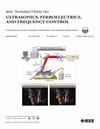Extended Field of View Imaging Through Correlation With an Experimental Database
IF 3.7
2区 工程技术
Q1 ACOUSTICS
IEEE transactions on ultrasonics, ferroelectrics, and frequency control
Pub Date : 2025-03-25
DOI:10.1109/TUFFC.2025.3553784
引用次数: 0
Abstract
In this article, a correlation-based (CB) ultrasound imaging technique is implemented to extend the field of view (FOV) in the inspected medium and to enhance image homogeneity. This implementation involves the acquisition, the compression, and the adaptation of a database of experimental reference signals (CB-Exp), consisting of backpropagated reflections on point-like scatterers at different positions, as an improvement over preceding implementations involving a database of numerical reference signals (CB-Num). Starting from a large database acquired in water to a database with a 99% size reduction that can be applied to tissue-like media, CB-Exp has been validated in vitro on a CIRS 040GSE phantom. When compared with the synthetic aperture focusing technique (SAFT) and CB-Num, CB-Exp results show reduced sensitivity to the probe’s directivity, allowing an FOV extension from 25° with SAFT to 75° with CB-Exp. In vivo testing on a piglet’s heart with CB-Exp imaging showed a 3.5-dB contrast improvement on the pericardium wall. Overall benefits of this method include a reduction in the background gCNR standard deviation (std) of 0.2 and a reduction in the std of 10 dB in the point-like targets levels, which translates to more homogeneous sensitivity in the axial and lateral directions of the image.通过与实验数据库的关联扩展视场成像。
本文实现了一种基于相关的超声成像技术,以扩大被检测介质的视场,增强图像的均匀性。该实现涉及实验参考信号数据库(CB-Exp)的采集、压缩和自适应,该数据库由不同位置的点状散射体上的反向传播反射组成,是对先前涉及数值参考信号数据库(CB-Num)的实现的改进。CB-Exp已经在CIRS 040GSE模型上进行了体外验证,从水中获取的大型数据库到可应用于类组织介质的数据库,大小减少了99%。与合成孔径聚焦技术(SAFT)和CB-Num相比,CB-Exp结果显示对探针指向性的灵敏度降低,允许视场从SAFT的25°扩展到CB-Exp的75°。在仔猪心脏的体内实验中,CB-Exp显像显示心包壁的对比度提高了3.5 dB。该方法的总体好处包括将背景gCNR标准偏差(std)降低0.2,并将点状目标水平的std降低10 dB,这意味着在图像的轴向和横向方向上具有更均匀的灵敏度。
本文章由计算机程序翻译,如有差异,请以英文原文为准。
求助全文
约1分钟内获得全文
求助全文
来源期刊
CiteScore
7.70
自引率
16.70%
发文量
583
审稿时长
4.5 months
期刊介绍:
IEEE Transactions on Ultrasonics, Ferroelectrics and Frequency Control includes the theory, technology, materials, and applications relating to: (1) the generation, transmission, and detection of ultrasonic waves and related phenomena; (2) medical ultrasound, including hyperthermia, bioeffects, tissue characterization and imaging; (3) ferroelectric, piezoelectric, and piezomagnetic materials, including crystals, polycrystalline solids, films, polymers, and composites; (4) frequency control, timing and time distribution, including crystal oscillators and other means of classical frequency control, and atomic, molecular and laser frequency control standards. Areas of interest range from fundamental studies to the design and/or applications of devices and systems.

 求助内容:
求助内容: 应助结果提醒方式:
应助结果提醒方式:


